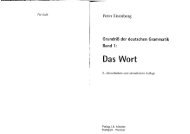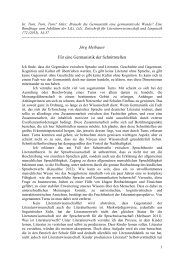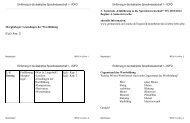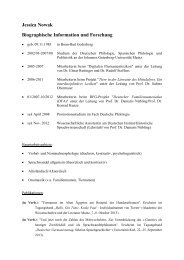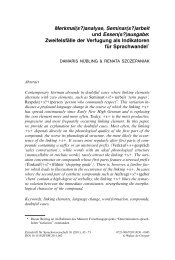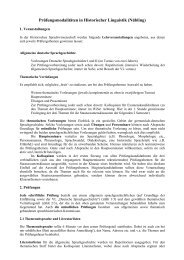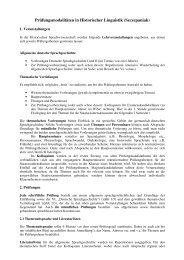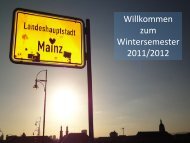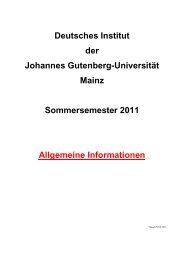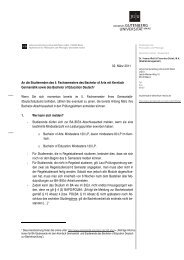Names in Multi-Lingual, Multi-Cultural and Multi-Ethnic Contact
Names in Multi-Lingual, Multi-Cultural and Multi-Ethnic Contact
Names in Multi-Lingual, Multi-Cultural and Multi-Ethnic Contact
You also want an ePaper? Increase the reach of your titles
YUMPU automatically turns print PDFs into web optimized ePapers that Google loves.
<strong>Names</strong> <strong>in</strong> <strong>Multi</strong>-L<strong>in</strong>gual, <strong>Multi</strong>-<strong>Cultural</strong> <strong>and</strong> <strong>Multi</strong>-<strong>Ethnic</strong> <strong>Contact</strong><br />
Proceed<strong>in</strong>gs of the 23 rd International Congress of Onomastic Sciences<br />
August 17-22, 2008, York University, Toronto, Canada<br />
Edited by<br />
Wolfgang Ahrens, York University<br />
Sheila Embleton, York University<br />
André Lapierre, University of Ottawa<br />
with the assistance of<br />
Grant Smith, Eastern Wash<strong>in</strong>gton University<br />
Maria Figueredo, York University<br />
Published by<br />
York University, Toronto, Canada<br />
2009<br />
ISBN 978-1-55014-521-2
Kathr<strong>in</strong> Dräger, Mirjam Schmuck, Germany 319<br />
The German Surname Atlas Project – Computer-Based Surname Geography<br />
Abstract<br />
Kathr<strong>in</strong> Dräger<br />
Mirjam Schmuck<br />
Germany<br />
The German Surname Atlas (Deutscher Familiennamenatlas, DFA) project is presented below. The<br />
surname maps are based on German fixed network telephone l<strong>in</strong>es (<strong>in</strong> 2005) with German postal districts as<br />
graticules. In our project, we use this data to explore the areal variation <strong>in</strong> lexical (e.g., Schröder/Schneider<br />
‘tailor’) as well as phonological (e.g., Hauser/Häuser/Heuser) <strong>and</strong> morphological (e.g., patronyms such as<br />
Petersen/Peters/Peter) aspects of German surnames. German surnames emerged quite early on <strong>and</strong><br />
preserve l<strong>in</strong>guistic material which is up to 900 years old. This enables us to draw conclusions from today’s<br />
areal distribution, e.g., on medieval dialect variation, writ<strong>in</strong>g traditions <strong>and</strong> cultural life. Conta<strong>in</strong><strong>in</strong>g not<br />
only German surnames but also foreign names, our huge database opens up possibilities for new areas of<br />
research, such as surnames <strong>and</strong> migration. Due to the close contact with Slavonic languages (orig<strong>in</strong>al<br />
Slavonic population <strong>in</strong> the east, former eastern territories, migration), orig<strong>in</strong>al Slavonic surnames make up<br />
the largest part of the foreign names (e.g., –ski 16,386 types/293,474 tokens). Various adaptations from<br />
Slavonic to German <strong>and</strong> vice versa occurred. These <strong>in</strong>cluded graphical (e.g., Dobsch<strong>in</strong>ski < Dobrzynski) as<br />
well as morphological adaptations (hybrid forms: e.g., Fuhrmanski) <strong>and</strong> folk-etymological re<strong>in</strong>terpretations<br />
(e.g., Rehsack < Czech Režak).<br />
1. The German surname system<br />
***<br />
In the German speech area, people generally started to use an addition to their given names from<br />
the eleventh to the sixteenth century, some even later. These additions, the so-called bynames,<br />
were at first not <strong>in</strong>heritable <strong>and</strong> not fixed, mean<strong>in</strong>g that one person could use different bynames.<br />
The term family names can only be used once the names become heritable <strong>and</strong> fixed. S<strong>in</strong>ce the<br />
seventeenth century official ord<strong>in</strong>ances were passed to stop changes <strong>in</strong> family names, to prescribe<br />
an obligatory family name <strong>and</strong> to fix the spell<strong>in</strong>g. F<strong>in</strong>ally, the Civil Code enforced <strong>in</strong> 1900 made<br />
the spell<strong>in</strong>g of family names <strong>in</strong> Germany permanent. The term surname comprises both the<br />
notions of byname <strong>and</strong> hereditary family name. In the follow<strong>in</strong>g the term surname is used because<br />
it is the most common term (cf. Barker; Spoerle<strong>in</strong>; Vetter; Viereck 2007: 1).<br />
One can dist<strong>in</strong>guish five groups of surnames accord<strong>in</strong>g to labell<strong>in</strong>g motivation:<br />
1. Surnames derived from first names, so-called patronymics: e.g., Werner, Walter or Peters. This<br />
means that the eponymous ancestor was named after the given name of his father <strong>in</strong> most cases,<br />
but occasionally also after that of his mother, a relative or another person of reference.<br />
2. Surnames derived from professions: The eponymous ancestor was named after his profession,<br />
his office or his class. The most frequent German family names belong to this group, such as<br />
Müller, Meier, Schmidt.<br />
3. Surnames derived from the provenance of recently arrived persons. In these cases, the<br />
eponymous ancestor was named after his l<strong>and</strong>, place or tribe of orig<strong>in</strong>, e.g., Hamburger, Unger,<br />
Beier.
Kathr<strong>in</strong> Dräger, Mirjam Schmuck, Germany 320<br />
4. Similar <strong>and</strong> sometimes hard to separate are the surnames derived from place of residence: The<br />
eponymous ancestor was named after the place where he lived, the surround<strong>in</strong>gs, the site, the<br />
material of the house <strong>and</strong> so on, for example Bach, Berger, Ste<strong>in</strong>hauser.<br />
5. Surnames derived from nicknames: The eponymous ancestor was named after physical,<br />
emotional or mental features, after th<strong>in</strong>gs, plants, animals, <strong>and</strong> so on, for example Kle<strong>in</strong>, Schwarz,<br />
Kluge.<br />
All German family names can be categorized <strong>in</strong>to these groups, but there are so-called<br />
mean<strong>in</strong>g differences, i.e., cases <strong>in</strong> which several labell<strong>in</strong>g motivations led to a s<strong>in</strong>gle surname.<br />
German surnames preserve l<strong>in</strong>guistic material which is up to 900 years old, from Middle<br />
High German, Middle Low German <strong>and</strong> Early New High German. This enables us to draw<br />
conclusions on medieval dialectal variation, writ<strong>in</strong>g traditions <strong>and</strong> cultural life us<strong>in</strong>g the current<br />
areal distribution.<br />
2. Presentation of the DFA<br />
The high degree of areal variation of the German surname system is now be<strong>in</strong>g made accessible<br />
by the German Surname Atlas project (Deutscher Familiennamenatlas), a cooperation between<br />
the universities of Freiburg <strong>and</strong> Ma<strong>in</strong>z under the direction of Prof. Dr. Konrad Kunze <strong>in</strong> Freiburg<br />
<strong>and</strong> Prof. Dr. Damaris Nübl<strong>in</strong>g <strong>in</strong> Ma<strong>in</strong>z. The project started <strong>in</strong> 2005 <strong>and</strong> will run till 2012.<br />
The most frequent <strong>and</strong> impressive examples are selected from the roughly one million<br />
different surnames <strong>in</strong> Germany to answer grammatical <strong>and</strong> lexical questions. The data basis<br />
consists of all fixed network telephone l<strong>in</strong>es <strong>in</strong> the Federal Republic of Germany <strong>in</strong> the year 2005<br />
as provided by the Deutsche Telekom AG. To come up with the approximate number of people<br />
who bear a specific name one multiplies the number of telephone l<strong>in</strong>es by 2.9. In Germany,<br />
telephone l<strong>in</strong>es are the only comprehensive <strong>and</strong> available data basis. They are arranged by postal<br />
code districts consist<strong>in</strong>g of five digits each.<br />
We usually do not create maps with a s<strong>in</strong>gle name on it but rather maps which comb<strong>in</strong>e<br />
several names with the same characteristics by us<strong>in</strong>g so-called regular expressions. For example,<br />
we can illustrate the spread<strong>in</strong>g of the dim<strong>in</strong>utive suffix -le (Map 1) by comb<strong>in</strong><strong>in</strong>g all surnames<br />
which end with -le, for example Hämmerle, which means ‘little hammer’. These are roughly<br />
8,700 different names (types) with about 300,000 telephone l<strong>in</strong>es (tokens) altogether. To name<br />
another example, you can show the emergence <strong>and</strong> the spell<strong>in</strong>g of the umlaut with the example<br />
Hauser/Häuser/Heuser (Map 2). In this case it does not matter whether the name is written with<br />
s, ss or ß, so all of these varieties are comb<strong>in</strong>ed <strong>in</strong> groups. As shown on the map, Hauser conta<strong>in</strong>s<br />
the types Hauser with 6818 tokens, Hausser 114, <strong>and</strong> Haußer 201. Häuser conta<strong>in</strong>s Häus(s)er<br />
1362+185, Häußer 438, Haeus(s)er 21+7, <strong>and</strong> Haeußer 3. Heuser conta<strong>in</strong>s Heus(s)er 3395+50,<br />
<strong>and</strong> Heußer 110.
Kathr<strong>in</strong> Dräger, Mirjam Schmuck, Germany 321<br />
Map 1. All German names with dim<strong>in</strong>utive suffix -le comb<strong>in</strong>ed.
Kathr<strong>in</strong> Dräger, Mirjam Schmuck, Germany 322<br />
Map 2. Emergence <strong>and</strong> spell<strong>in</strong>g of the umlaut <strong>in</strong> Hauser/Häuser/Heuser.<br />
It is possible to create relative maps, which show the percentage of all telephone l<strong>in</strong>es <strong>in</strong> the<br />
correspond<strong>in</strong>g postal code district, or absolute maps, which show the actual number of telephone<br />
l<strong>in</strong>es <strong>in</strong> the postal code district. Absolute maps are only convenient for surnames with less than<br />
about 1,000 tokens because the major urban centres produce the biggest spots, as the example of<br />
the surname Richter (59,950 tokens) shows (Maps 3 <strong>and</strong> 4). One can use circular charts, like<br />
those on Maps 3 <strong>and</strong> 4, or areal charts (Map 5). One can also comb<strong>in</strong>e both as shown on Map 6,<br />
which shows the spread<strong>in</strong>g of the apocope of the e <strong>in</strong> the nickname Lange/Lang. Indicated is not<br />
only the spread<strong>in</strong>g with the circular charts or the colour<strong>in</strong>g of an area, but also the density with<br />
the size of the circular charts. The maps are adjustable to one-, two-, three- or five-digit postal<br />
code districts. In most cases it has proved most suitable to use three-digit postal code districts like<br />
on Map 7, which shows the spell<strong>in</strong>g of the profession name Schmitz/Schmitt/Schmi(e)d. Five-digit<br />
maps are used to show the spread<strong>in</strong>g of less frequent names or to show details (Map 8).<br />
The atlas will conta<strong>in</strong> two parts, one with grammatical topics <strong>and</strong> one with lexical topics. The<br />
first part, conta<strong>in</strong><strong>in</strong>g phonology, graphemics, morphology <strong>and</strong> syntax, will be published <strong>in</strong> two<br />
volumes; the first volume will be ready <strong>in</strong> 2009. The second part will be divided <strong>in</strong>to different<br />
sections based on the five surname types: patronyms, profession names, provenance names,<br />
residence names, <strong>and</strong> nicknames.<br />
Each map is accompanied by a detailed commentary conta<strong>in</strong><strong>in</strong>g six sections: We start by<br />
describ<strong>in</strong>g which topic is be<strong>in</strong>g illustrated <strong>and</strong> why this special case has been chosen. Usually,
Kathr<strong>in</strong> Dräger, Mirjam Schmuck, Germany 323<br />
very frequent names are selected which are preferably etymologically unambiguous <strong>and</strong> deliver a<br />
conv<strong>in</strong>c<strong>in</strong>g map. Secondly, the quantitative database for the map is <strong>in</strong>dicated with the regular<br />
expression applied, the output types <strong>and</strong> the frequencies of the different types. The third section<br />
conta<strong>in</strong>s etymological <strong>in</strong>formation about the names. Section four comprises further details about<br />
the map <strong>and</strong> the so-called Nebenkarten. These smaller maps conta<strong>in</strong> details from the ma<strong>in</strong> map or<br />
illustrate the same topic with other examples. In section five, historical forms of the names are<br />
listed. The German Surname Atlas is the first l<strong>in</strong>guistic atlas which considers data both from the<br />
present <strong>and</strong> from the past reach<strong>in</strong>g back to the Middle Ages. The last section conta<strong>in</strong>s<br />
bibliographical references, cross references <strong>and</strong> further <strong>in</strong>formation, for example the frequency<br />
<strong>and</strong> spread<strong>in</strong>g of the names <strong>in</strong> neighbour<strong>in</strong>g countries.<br />
Map 3. Relative distribution for Richter.
Kathr<strong>in</strong> Dräger, Mirjam Schmuck, Germany 324<br />
Map 4. Absolute distribution for Richter.
Kathr<strong>in</strong> Dräger, Mirjam Schmuck, Germany 325<br />
Map 5. Areal chart (relative) for Richter.
Kathr<strong>in</strong> Dräger, Mirjam Schmuck, Germany 326<br />
Map 6. Apocope <strong>in</strong> Lange/Lang.
Kathr<strong>in</strong> Dräger, Mirjam Schmuck, Germany 327<br />
Map 7. Distribution of Schmitz, Schmitt, <strong>and</strong> Schmi(e)d, three-digit postal code districts.<br />
Map 8. Distribution of Schmitz, Schmitt, <strong>and</strong> Schmi(e)d, five-digit postal code districts.
Kathr<strong>in</strong> Dräger, Mirjam Schmuck, Germany 328<br />
3. Case study: Hermanski, Szulczynski etc. – Germano-Slavic hybrids<br />
Our huge database conta<strong>in</strong>s not only German surnames but also foreign names <strong>and</strong> <strong>in</strong> particular<br />
hybrid names. As a result of the close contact with Slavonic languages, orig<strong>in</strong>al Slavonic<br />
surnames <strong>and</strong> Germano-Slavic hybrids make up the biggest part. Hybrid names, such as<br />
Hermanski, Szulczynski etc. will not be taken <strong>in</strong>to account <strong>in</strong> the DFA. Nevertheless, they<br />
constitute a surpris<strong>in</strong>gly large number of German surnames. Due to computer-based research they<br />
are now available <strong>in</strong> great variety <strong>and</strong> thus provide a new <strong>in</strong>terest<strong>in</strong>g field of research.<br />
3.1 Slavonic names <strong>in</strong> Germany<br />
Accord<strong>in</strong>g to Naumann (2007), 15% of surnames <strong>in</strong> his data are Slavonic <strong>in</strong> orig<strong>in</strong>. This fact is a<br />
result of the long language contact between German <strong>and</strong> West Slavonic languages, especially<br />
Polish <strong>and</strong> Czech. Intensive language contact is above all due to the former eastern territories of<br />
the German Reich <strong>and</strong> the Slavonic settlement <strong>in</strong> the eastern part of Germany. Further Slavonic<br />
<strong>in</strong>fluence is due to the displacement of the German partly assimilated population <strong>in</strong> the eastern<br />
territories after the Second World War <strong>and</strong> their return to Germany. Last but not least, there have<br />
been a great number of Polish immigrants especially <strong>in</strong> <strong>in</strong>dustrial areas, above all <strong>in</strong> the Ruhr<br />
area. Those migrant labourers came ma<strong>in</strong>ly <strong>in</strong> the middle of the 19 th century (cf. Hengst 2001;<br />
Jachnow 1991/92; Rymut/Hoffmann 2006: VII–XIV; Schmalz-Jacobsen/Hansen 1995: 385–401,<br />
501–511).<br />
Map 9. Polish names <strong>in</strong> -ski 16,386 types/293,474 tokens
Kathr<strong>in</strong> Dräger, Mirjam Schmuck, Germany 329<br />
Map 10. Czech names <strong>in</strong> –sky 4,408 types/41,535 tokens<br />
To illustrate the great number of Slavonic names, Map 9 shows the distribution of all<br />
surnames ( 2 tokens) end<strong>in</strong>g <strong>in</strong> the typical Polish suffix -ski (16,386 different names, total<br />
293,474 tokens). As we would have expected from the historical background Polish names are<br />
concentrated above all <strong>in</strong> the Ruhr area, with a lower concentration of names end<strong>in</strong>g <strong>in</strong> -ski<br />
distributed <strong>in</strong> the northeast. Note their high token-frequency. Map 10 shows the distribution of<br />
names with the Czech variant of the suffix (4,408 types/41,535 tokens). Those names are<br />
concentrated <strong>in</strong> the Sorbian area <strong>and</strong> <strong>in</strong> southeastern Germany. 1<br />
Because of the historical background, we have to deal with two k<strong>in</strong>ds of language contact:<br />
German names <strong>in</strong> Slavonic speak<strong>in</strong>g surround<strong>in</strong>gs <strong>and</strong> Slavonic names <strong>in</strong> Germany. Likewise,<br />
dist<strong>in</strong>ction has to be made between the two directions of adaptation: from Slavonic to German<br />
<strong>and</strong> vice versa. 2<br />
3.2 Levels of adaptation<br />
Adaptations occur on different levels: four levels can be dist<strong>in</strong>guished (adaptations of Polish<br />
names <strong>in</strong> the Ruhr area cf. Burghardt 1975; Menge 2000):<br />
1. Graphical<br />
Szymanski > Schimanski, Kubic > Kubitz<br />
Schulz > Szulz, Friedrich > Frydrych<br />
2. Phonological<br />
Brzeski > Breski, Majchrzak > Maischak
3. Morphological<br />
Blazek > Blaschke, Kubik > Kubig<br />
Baier > Bajerski, Schulz > Szul<strong>in</strong>ski<br />
4. Lexical, i.e., translation or folk-etymological re<strong>in</strong>terpretation:<br />
Dombrowski > Dombrück, Majchrzak > Maischatz<br />
Kathr<strong>in</strong> Dräger, Mirjam Schmuck, Germany 330<br />
Below we will take a closer look at morphological adaptations, especially cases such as Bajerski,<br />
where German surnames are adapted to Slavonic <strong>and</strong> second folk-etymological re<strong>in</strong>terpretations<br />
of orig<strong>in</strong>al Slavonic names, the case Majchrzak > Maischatz.<br />
3.3 Morphological adaptations<br />
First of all some short remarks on the Polish surname system: Polish surnames are characterized<br />
by their typical suffixes, the most common is -ski, reflected to an equal degree <strong>in</strong> our data.<br />
Orig<strong>in</strong>ally the suffix -ski is added to property names (Tarnów > Tarnowski ‘owner of<br />
Tarnów’). Thus -ski was typical for surnames of the nobility. Later on the suffix occurred <strong>in</strong><br />
provenance names (Kraków > Krakowski). Due to its enormous prestige, -ski came off as an<br />
onymical suffix <strong>and</strong> was no longer restricted to provenance names, but comb<strong>in</strong>ed with every base<br />
(Kowalski < kowal ‘smith’, Szymanski < Szymon, Simon). The suffix -ski is still extremely<br />
frequent: Among the 100 most frequent Polish surnames 65 end <strong>in</strong> -ski (cf. Skowronek 2001:<br />
186f.). Often the suffix is comb<strong>in</strong>ed with other suffixes: -owski (Kwiatkowski), -ewski<br />
(Wisniewski), -<strong>in</strong>ski (Dobil<strong>in</strong>ski).<br />
Other frequently used Polish suffixes:<br />
-k- suffixes (= dim<strong>in</strong>utive suffix): -ak (Nowak), -ek (Kowalek), -ik (Wojcik), -czak (Idczak),<br />
-czyk (Jaworczyk)<br />
-icz- suffixes: -icz (Panicz), -owicz (Jurakowicz), -ewicz (Chudakiewicz)<br />
Those Polish suffixes have also been used to “slavonize” German surnames. We have chosen the<br />
example Fuhrmann which means ‘waggoner’ (Table 1). In our data there are 41 different names<br />
altogether with a total of 547 tokens.<br />
The most frequent suffix is -ek (12 types/269 tokens), followed by -ski (14 types/161 tokens).<br />
Other, less frequent suffixes, are -ak, -czyk <strong>and</strong> -wicz. All these suffixes are Polish: the suffix -ek<br />
could be either Polish or Czech.
-ski<br />
161 tokens<br />
-ek<br />
269 tokens<br />
-ak<br />
67 tokens<br />
-czyk<br />
10 tokens<br />
-wicz<br />
40 tokens<br />
Kathr<strong>in</strong> Dräger, Mirjam Schmuck, Germany 331<br />
Forman(n)ski 63+1, Fu(h)rmanski 37+13, Fuhrmannsky 4,<br />
Furmansky 1, Formansky 1, Formanske 2, Furmanska 1;<br />
Formanowski 15, Furmanowsky 1<br />
Furman(n)ek 142+12, Formanek 79, Fuhrmanneck 6,<br />
Fuhrman(n)ek 3+6, Formaneck 1;<br />
Formatsche(c)k 13+1, Formacek 4<br />
Furmaniak 55, Formaniak 5;<br />
Furmanczak 3, Fuhrmanczak 1, Furmansczak 1<br />
Furmanczyk 10<br />
Formanowicz 14, Formanowitz 8, Furman(t)owicz 2+1<br />
Furmanowitz 2, Furmankiewicz 2<br />
Table 1. Hybrid forms of the German surname Fuhrmann ‘waggoner’<br />
Table 2 (see appendix) shows the large number of hybrid German surnames with Polish -ski<br />
suffixes. Taken <strong>in</strong>to account are all names with a m<strong>in</strong>imum of 5 tokens. In our data there are 38<br />
different names altogether (870 tokens) with simple -ski suffix. Comb<strong>in</strong>ations occur more often.<br />
The most frequent suffixes are -owski (45 types/922 tokens) <strong>and</strong> -kowski (31 types/396 tokens).<br />
Other comb<strong>in</strong>ations are -ewski or -czewski <strong>and</strong> -<strong>in</strong>ski or -czynski. Similar to Polish surnames, -ski<br />
suffixes occur with all five name types: profession names (Lehmanski < ‘tenant’, Schuttkowski <<br />
‘marksman’), patronyms (Hermanski, Willamowski), provenance or residence names (Bajerski <<br />
Baier ‘person from Bavaria’, Straßewski < Straßner ‘person who lives near the street’) <strong>and</strong><br />
nicknames (Grotkowski < Grot(e) ‘tall person’, Schwart<strong>in</strong>ski < Schwarz ‘black haired person’).<br />
3.4 Folk-etymological re<strong>in</strong>terpretations of Slavonic surnames<br />
A common way of adapt<strong>in</strong>g Slavonic names to the German system is folk-etymological<br />
re<strong>in</strong>terpretation. We have to deal with two k<strong>in</strong>ds of adaptation: semi- <strong>and</strong> total-adaptation. Semiadapted<br />
forms are cases such as Korczak > Korschatz (Kor ‘?’ + Schatz ‘treasure’) <strong>and</strong><br />
Kierzkowski > Kirschkowski (Kirsch ‘cherry’ + -kowski ‘?’). Examples for totally adapted forms<br />
are Kierzkowski > Kirschkopf (Kirsch ‘cherry’ + Kopf ‘head’) <strong>and</strong> Melczak > Mehlsack (Mehl<br />
‘flour’ + Sack ‘sack’). Examples <strong>in</strong> tables 3 <strong>and</strong> 4 show the folk-etymological re<strong>in</strong>terpretation of<br />
the frequent Slavonic suffix -czak. Table 3 illustrates the adaption to the German word Schatz<br />
‘treasure’. The first part of the table concerns cases of total adaption to German (Mannschatz,<br />
Bauschatz, Maischatz, Goldschatz etc.), where both elements of the compound are fully<br />
transparent. In the second part of the table semi-adapted names are subsumed such as Buschatz,<br />
Waschatz <strong>and</strong> Marschatz where the first element is opaque.
Kathr<strong>in</strong> Dräger, Mirjam Schmuck, Germany 332
Adapted names end<strong>in</strong>g <strong>in</strong><br />
-schatz (database DFA)<br />
Kathr<strong>in</strong> Dräger, Mirjam Schmuck, Germany 333<br />
Possible Slavonic base<br />
Man(n)schatz ‘man’- 15+59 < Manczak (< Manomir)<br />
Bauschatz ‘build<strong>in</strong>g’ + ‘treasure’ 40 < Buczak (< bucze ‘cry, grumble’)<br />
Buchschatz ‘book’- 17 < Buchczak (< buchta ‘piece of bread, cake’)<br />
Maischatz, Meischatz ‘May’- 25+10 < Majczak, Maichrzak (< Melchior)<br />
Goldschatz ‘gold’- 2 < ?Golczak (< go y ‘bare, fundless’), ?Kolczak (< Nicholas)<br />
Bockschatz ‘buck’- 9 < ?Boguslav<br />
Gro(ß/ss)schatz ‘big’- 2+1 < Grze(sz)czak (< Grzegorz, Gregor)<br />
Buschatz 45 < Buczak (< bucze ‘cry, grumble’)<br />
Waschatz 24 < Waczak (< Wac aw)<br />
Marschatz 12 < Marczak (< Marek)<br />
Korschatz 3 < Korczak (< korczak ‘wooden cup’)<br />
Laschatz 2 < Laszak (< azarz, azkarz)<br />
Wierschatz 2 < Wierzak (< wiara ‘faith’, Veronika)<br />
Table 3. Folk-etymological re<strong>in</strong>terpretation of slav. -czak > -schatz ‘treasure’<br />
Table 4 exemplifies the adaption of Slav. -czak to Germ. Sack ‘sack’. The DFA-data conta<strong>in</strong>s<br />
compounds such as Maisack, Brotsack <strong>and</strong> Milchsack, Rehsack. All of them are totally<br />
transparent, but only a few of them make sense, for example Mehlsack ‘flour sack’. Obviously<br />
most of these names represent nonsense compounds (Rehsack, Maisack). This name type calls to<br />
m<strong>in</strong>d bipartite Swedish names such as Stenqvist ‘stone twig’, Malmqvist ‘ore twig’, etc. Those<br />
names are <strong>in</strong> some way ideal proper names: They are dist<strong>in</strong>ct from common nouns without be<strong>in</strong>g<br />
opaque (cf. Nübl<strong>in</strong>g 2000).
4. Conclusion<br />
Kathr<strong>in</strong> Dräger, Mirjam Schmuck, Germany 334<br />
Adapted names end<strong>in</strong>g <strong>in</strong><br />
-sack (database DFA)<br />
Possible Slav. base<br />
Maisack ‘May’+ ‘sack’ 51 < Majszak, Majchrzack (< Majcher, Melchior)<br />
Milchsack ‘milk’- 32 < Mleczak, Milczak < ?Mikolayczak<br />
Brotsack, -d- ‘bread’- 16+1 < Broszak, Broszczak (< Bronislav)<br />
Rehsack ‘deer’- 11 < czech Režak ‘butcher’s knife’<br />
Bauersack ‘farmer’- 10 < Burczak (< burczec ‘shout, growl’<br />
Buttersack ‘butter’- 6 < ?Burczak<br />
Heusack ‘hay’- 6 < ?<br />
Liebsack ‘dear’- 4 < Lipczak (< lipa ‘lime-tree’)<br />
Strohsack ‘straw’- 2 < Strozak (< stroz ‘watchman’)<br />
Mehlsack ‘flour’ - 2 < Melczak (< Miloslav; mjel ak ‘dumb person’)<br />
Wollsack ‘wool’- 2 < Wolnyczak, Wolszczak (< wólny ‘free’)<br />
Bartsack ‘beard’- 1 < Bart(osz)czak (Bartosz < Bartolomäus)<br />
We<strong>in</strong>sack ‘w<strong>in</strong>e’- 1 < Wojczak (< wóit ‘reeve’)<br />
Table 4. Folk-etymological re<strong>in</strong>terpretation of Slav. -(c)zak > -sack ‘Sack’<br />
Computer-based surname geography enables us to systematically register all surnames <strong>in</strong> their<br />
enormous variety. Thus even names with fewer tokens (e.g., hybrid names) can be taken <strong>in</strong>to<br />
account <strong>and</strong> etymologies can be verified. In addition to anthroponomastics, surnames provide a<br />
huge database for further <strong>in</strong>terdiscipl<strong>in</strong>ary research. Conta<strong>in</strong><strong>in</strong>g l<strong>in</strong>guistic material from Middle<br />
High German, Middle Low German, <strong>and</strong> Early New High German, German surnames represent<br />
an important database for historical l<strong>in</strong>guistics as well. Furthermore, surnames provide a rich<br />
source for other fields of research, e.g., migration <strong>and</strong> all k<strong>in</strong>ds of historical, social or cultural<br />
studies, genetics <strong>and</strong> many more.<br />
Notes<br />
1. Ronge (1968/70) gives a list of Slavonic names <strong>in</strong> the Ruhr area; the dictionary by Rymut; Hoffmann<br />
(2006: Vol. 1, A-F) provides a broad collection based on fixed network telephone l<strong>in</strong>es. cf. Neumann<br />
(1967) for Slavonic names <strong>in</strong> Saxonia; for Sorbian names see Wenzel (1987–94; 1999).<br />
2. Farkas (this volume) provides a similar approach for the situation <strong>in</strong> Hungary. He po<strong>in</strong>ts out that<br />
<strong>in</strong>fluence is exerted both by Hungarian surnames on foreign names (e.g., German or Slavonic names) <strong>and</strong><br />
by foreign names on the dom<strong>in</strong>ant Hungarian system.<br />
References<br />
Barker, Stephanie, Stefankai Spoerle<strong>in</strong>, Tobias Vetter, <strong>and</strong> Wolfgang Viereck. 2007. An Atlas of English<br />
Surnames. Frankfurt am Ma<strong>in</strong> <strong>and</strong> other cities: Lang.
Kathr<strong>in</strong> Dräger, Mirjam Schmuck, Germany 335<br />
Burghardt, Werner. 1975. Namensänderungen slawischer Familiennamen im Ruhrgebiet. In: Bellmann,<br />
Günter, Günter Eifler, <strong>and</strong> Wolfgang Kleiber (eds.), Festschrift für Karl Bischoff zum 70. Geburtstag,<br />
271–286. Köln–Wien: Böhlau.<br />
Dammel, Antje, <strong>and</strong> Mirjam Schmuck. 2008. Der Deutsche Familiennamenatlas (DFA): Relevanz<br />
computergestützter Familiennamengeographie für die Dialektgeographie. In: Elspaß, Stephan, <strong>and</strong><br />
Werner König (eds.), Sprachgeographie digital: die neue Generation der Sprachatlanten, 73–104;<br />
254–260. Hildesheim <strong>and</strong> other cities: Olms.<br />
Farkas, Tamás (this volume). Surnames of foreign orig<strong>in</strong> <strong>in</strong> language contact situation: the reasons <strong>and</strong><br />
ways of their changes <strong>and</strong> their <strong>in</strong>fluence on the surname stock <strong>in</strong> Hungary.<br />
Goossens, Jan. 1996. Familiennamengeographie. In: Eichler, Ernst, et al. (eds.), Namenforschung: e<strong>in</strong><br />
<strong>in</strong>ternationales H<strong>and</strong>buch zur Onomastik, Vol 2, 1141–1153. Berl<strong>in</strong>–New York: de Gruyter (HSK,<br />
11.2).<br />
Hellfritzsch, Volkmar. 1966. Zum Problem der slawischen Personennamen im Vogtl<strong>and</strong>. Onomastica<br />
Slavogermanica II, 49–57.<br />
Hengst, Karlhe<strong>in</strong>z. 2001. Mazur und Motzki: slawische Familiennamen als kulturgeschichtliche Zeugen. In:<br />
Eichhoff, Jürgen, Wilfried Seibicke, <strong>and</strong> Michael Wolffsohn (eds.), Name und Gesellschaft: soziale<br />
und historische Aspekte der Namengebung und Namenentwicklung, 209–225. Mannheim <strong>and</strong> other<br />
cities: Dudenverlag.<br />
Jachnow, Helmut. 1970. Die slavischen Personennamen <strong>in</strong> Berl<strong>in</strong> bis zur tschechischen E<strong>in</strong>w<strong>and</strong>erung im<br />
18. Jahrhundert: e<strong>in</strong>e onomastisch-demographische Untersuchung. Wiesbaden: Harrassowitz.<br />
Jachnow, Helmut. 1991/92. Deutschl<strong>and</strong> und se<strong>in</strong>e slavische Namenwelt. Vestische Zeitschrift 90/91, 339–<br />
346.<br />
Kunze, Konrad. 1990/91. Projekt e<strong>in</strong>es Familiennamen-Atlas der Bundesrepublik Deutschl<strong>and</strong>.<br />
Illustrationsbeispiel: Namen aus mhd. rûch. Mit 7 Karten. Beiträge zur Namenforschung (N.F.) 25<br />
(1990), 1–15; 26 (1991), 24.<br />
Kunze, Konrad. 2004. dtv-Atlas Namenkunde: Vor- und Familiennamen im deutschen Sprachgebiet. 4th<br />
edition. München: dtv.<br />
Kunze, Konrad, <strong>and</strong> Richard Kunze. 2002. Verbreitungskarten von Familiennamen <strong>in</strong> Deutschl<strong>and</strong>. Der<br />
Sprachdienst 46/6, 209–217.<br />
Kunze, Konrad, <strong>and</strong> Richard Kunze. 2003. Computergestützte Familiennamengeographie: kle<strong>in</strong>er Atlas zur<br />
Verbreitung der Apokope. Beiträge zur Namenforschung (N.F.) 38/2, 121–324.<br />
Kunze, Konrad, <strong>and</strong> Damaris Nübl<strong>in</strong>g,. 2007. Der Deutsche Familiennamenatlas (DFA): Konzept,<br />
Konturen, Kartenbeispiele. Beiträge zur Namenforschung (N.F.) 42/2, 125–172.<br />
Menge, He<strong>in</strong>z H. 2000. Namensänderungen slawischer Familiennamen im Ruhrgebiet. Niederdeutsches<br />
Wort 40, 119–132.<br />
Naumann, Horst. 2007. Das große Buch der Familiennamen: Alter, Herkunft, Bedeutung. Augsburg:<br />
Bassermann.<br />
Neumann, Isolde. 1967. Slawische Personennamen im Oschatzer L<strong>and</strong>. Onomastica Slavogermanica III,<br />
77–97.<br />
Nübl<strong>in</strong>g, Damaris. 2000. Auf der Suche nach dem idealen Eigennamen. Beiträge zur Namenforschung<br />
(N.F.) 35/3, 275–302.<br />
Nübl<strong>in</strong>g, Damaris, <strong>and</strong> Konrad Kunze,. 2005. Familiennamenforschung morgen: Der Deutsche<br />
Familiennamenatlas (DFA). In: Brendler, Andrea <strong>and</strong> Silvio Brendler (eds.), Namenforschung morgen:<br />
Ideen, Perspektiven, Visionen, 141–151. Hamburg: Baar.<br />
Nübl<strong>in</strong>g, Damaris, <strong>and</strong> Konrad Kunze. 2006. New perspectives on Müller, Meyer, Schmidt: computerbased<br />
surname geography <strong>and</strong> the German Surname Atlas project. Studia anthroponymica<br />
sc<strong>and</strong><strong>in</strong>avica 24, 53–85.<br />
Ronge, Paul. 1968–1970. Slawische Namen im Ruhrgebiet. Vestische Zeitschrift 70–72, 104–132.
Kathr<strong>in</strong> Dräger, Mirjam Schmuck, Germany 336<br />
Rymut, Kazimierz, <strong>and</strong> Johannes Hoffmann, (eds.). 2006. Die Familiennamen polnischer Herkunft im<br />
Ruhrgebiet. Vol.1. Kraków: Verlag des Instituts für Polnische Sprache PAN.<br />
Schmalz-Jacobsen, Cornelia, <strong>and</strong> Georg Hansen (eds.). 1995. Ethnische M<strong>in</strong>derheiten <strong>in</strong> der<br />
Bundesrepublik Deutschl<strong>and</strong>: e<strong>in</strong> Lexikon. München: Beck.<br />
Skowronek, Katarzyna. 2001. Wspó czesne nazwisko polskie: studium statystyczno. Krakow: DWN.<br />
Wenzel, Walter. 1987–94. Studien zu sorbischen Personennamen. 4 Vol. Vol. I Systematische Darstellung,<br />
Vol. II,1 + II, 2 Historisch etymologisches Wörterbuch, Vol. III Namenatlas und Beiträge zur<br />
Siedlungsgeschichte. Bautzen: Domow<strong>in</strong>a.<br />
Wenzel, Walter. 1999. Lausitzer Familiennamen slawischen Ursprungs. Bautzen: Domow<strong>in</strong>a.<br />
Mirjam Schmuck Kathr<strong>in</strong> Dräger<br />
Johannes-Gutenberg Universität Albert-Ludwigs-Universität<br />
FB 05 Deutsches Institut Deutsches Sem<strong>in</strong>ar I<br />
55099 Ma<strong>in</strong>z 79085 Freiburg<br />
GERMANY GERMANY<br />
mschmu@uni-ma<strong>in</strong>z.de kathr<strong>in</strong>.draeger@germanistik.uni-freiburg.de



